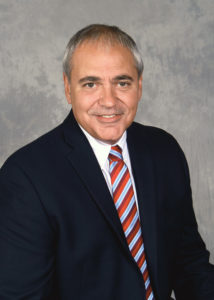There is a common thread that all successful leaders share: the ability to take what they learn and experience and develop habits from them that lead to favorable outcomes. Oswego County Business magazine spoke to five local leaders who shared their five habits of success
By Lou Sorendo
Mark Southwick
Plant manager
Huhtamaki, Fulton
1. Change happens — learn to get comfortable with it
We often find comfort in repeatability. Previously applied methods or experiences offer the security of predictable results. This comfort level can cause fear, worry or concern regarding an upcoming change in our life. Understanding the things underlying these concerns is powerful when used as a tool to mitigate the risks associated with upcoming change.
When you personally gain a comfort level with those concerns, this understanding can be used as a tool to gain buy-in from others. By learning what others fear or are concerned about regarding an upcoming change helps you to recognize other potential impacts you may have not foreseen. Working through change with those who are experiencing it enables you to bond into a more cohesive team.
2. Leading is about other people, silly
Understanding myself, my personality type and tendencies were some of my first steps in my leadership journey. However, this alone has not been what has delivered the best results. Learning how to apply the knowledge I have gained about myself to best support others has been vastly more successful. The “Golden Rule” is good: “Do onto others as you want done to yourself.” However, the “Platinum Rule” is better: “Do onto others as they want done onto themselves.”
When I manage my personal tendencies in a genuine way to interact and provide leadership more in line with the tendencies of the individual I am working with, as opposed to my own, there is a more open exchange of thought and the outcome tends to be better.
3. The glass is half full
Risk management and navigating around potential areas of failure is a very important part of a leader’s responsibilities. However, a pitfall of this is that it can lead to a very pessimistic viewpoint.
Envisioning and communicating positive outcomes, instead of emphasizing the potential risks or failure points, is a much more powerful tool for motivating people. This will make you and your team happier as well. Research shows you will be healthier if you have a more positive outlook on things. If you expect something good to happen, then it is more likely positive results will occur, and the inverse is also true. Like the saying goes: “Whether you think you can, or you think you can’t, you’re right!” The answer is the glass is half–full and you can.
4. Take time to recharge
Life can be exhausting physically, mentally and emotionally. Our body does a good job of letting us know when we are physically tired. However, we can sometimes overlook or ignore the signs of being mentally and emotionally tired.
Being mentally or emotionally tired provides less than optimal results, leads to unfavorable interpersonal exchanges and eventually can grind you down. Strong leaders learn the signs when they are mentally or emotionally tired and take steps to recharge. Each person is different in how they recharge, and I personally find having various types of work I perform in a day helps minimize my mental fatigue. In addition, finding moments to experience introverted activities where I can process things at my own pace are tremendously beneficial to my emotional comfort level.
5. Find joy each and every day
Every day each of us does great things; sometimes is it harder to see than others, but it is there. A saying those who work with me hear me say from time to time is, “we need to make sure we enjoy the misery.” Working with a team that comes together in time of crisis can be exhilarating.
Accomplishing a portion of a complex task or recognizing the positive impact you have made is joyful. Joy will change your demeanor and outlook on the day and will spread to those around you. Laugh with those you spend time with, praise people when they do something good, say thank you often and put yourself in a position to smile.
These are just a few things that will bring joy into your life and the life of those around you. You and your organization will be more productive, time will fly by and you will be able to endure challenging times easier.

Deborah F. Stanley
President
SUNY Oswego
1. Foster a “why” mentality and culture, and a “what if we didn’t do it that way?” investigation
Turning an idea or a problem around to look at every side keeps me thinking fresh, encourages deeper analysis of situations, and always yields new ideas.
2. “Let it Steep”
Give things, initiatives, decisions and impressions time to brew. In American culture, we often place a high value not only in decisive action but quick action. One of the best pieces of advice I ever received was to take a tough question — a complaint, a request, a press inquiry (as long as it’s not an emergency) aside — and think it through, perhaps seek expert advice, study the issue and assess likely outcomes before taking action.
3. Remember the “Golden Rule”
Value being human and express the value you have for others in words and deeds. This is good for you and good for the organization. The message is never just about work. Even if you never talk about anything else, you will be judged on the way you treat the individual — on the respect, compassion, fairness, and dignity you do or don’t display.
4. Pay it forward
Hard as it may be to believe, but the world is going to outlive you! And although we would all like to believe that no one could be as wonderful, smart, accomplished and — well, just perfect — as we are, if leadership counts, and I believe it does, it is incredibly worthwhile to spend time cultivating, encouraging, and guiding the next generation so it will be ready — confident and experienced — to take the reins.
5. In higher education we talk about “habits of the mind”
Make being a constant learner — a seeker of knowledge, not just information — your main habit. It takes a bit of humility to recognize that this vast world will never be fully known, and even more to absorb that in this era of vastly expanding knowledge in about every field, you will never know it all.

William ‘Billy’ Barlow
Mayor
City of Oswego
1. Remember that everything is manageable
During my term as mayor, we’ve had some great successes, but it hasn’t come easy. We’ve had challenges and setbacks, most of which were out of our control to a certain extent. It is important to remember that everything is manageable and your reaction and response to a problem or crisis is key. Rather than get upset or frustrated, identify the problem, find the solution and begin managing through it. For every problem there is a solution — mitigate the negative impact and keep moving forward.
2. Nothing is impossible and “no” is not an answer
I’ve learned that usually every idea or project is met with resistance, regardless of how great it may be. When I propose a project or come up with a new idea, usually somebody says it can’t be done or focuses on reasons why it can’t or won’t happen. My attitude is, “It can be done; we just have to find a way.” We need to spend less time focusing on reasons something can’t happen, and put as much energy into ways to make it happen.
“We’ve never done it that way” or “it can’t be done” aren’t acceptable answers and as a leader, you need to maintain that attitude and have that mindset filter throughout any organization, or in my case, all levels of management, employees, and the legislative branch of government.
3. Do not try to make everyone happy
If you’re setting out to make big changes, you’re going to ruffle some feathers along the way. There is no way around it. Generally, a sign of a good deal is nobody is 100% happy and nobody is 100% angry. I’ve learned that whether its negotiating with someone one-on-one, or negotiating personnel contracts, legislation, projects or any other situation, as a leader, you have the responsibility of considering the impact your decision is going to have on everyone involved. It is critically important to keep the greater good for the people and for the community in mind, do your best to do the right things for the right reasons, and accept that any time you make a big decision, not everyone is going to agree and there is nothing wrong with that.
4. Strike the balance of not being a micro-manager and not being totally hands-off either
As mayor, I have a vision for the community and set our goals in the beginning of our term. While you want to know everything that is going on all the time, you have to allow your department heads and employees to provide their input and add to the dialogue. I’ve found that if I, as mayor, set a very clear vision for the city and I make the vision known to the department heads, employees and the council, they will naturally work toward that vision and our goals. At that point, they have the ability to make decisions, provide valuable input, and generate ideas that are naturally consistent with your overall vision and you’re all rowing in the same direction. This allows you to not be involved in the minutia of every decision and allows your team the flexibility necessary to be creative and enhance the original idea.
5. Be consistent
As a leader, I think it is key to be consistent in everything you do. From your demeanor at work, to how you react to situations, to making decisions, if you’re consistent across the board, your department heads and employees know what to expect and can work toward the desired outcomes from the get-go.
I try to treat everybody the same way, approach every situation the same way, and would like to think that when anybody approaches me on any given day, they know what they can expect.

Michael Harlovic
President-CEO
Oswego Health
1. Be a personable leader
Take the time to get to know your employees, walk the floor or make your rounds and let them see you as a real person. Establishing rapport with your staff will help strengthen retention within your organization.
2. Overly communicate to everyone in your organization
Once you’ve set your priorities, goals and objectives, make sure to communicate them to everyone in your organization. Sharing your vision with staff is critical to ensure everyone is moving in the same direction and will reinforce their role in the growth of the company.
3. Surround yourself with thought leaders
Seek talented employees for your organization that will help grow your business, but also individuals that will challenge you and motivate you to be the best leader you can be.
4. Practice being a great listener
Listen to your staff and your patients or customers. You don’t always have to act on the ideas or suggestions; however, by simply listening to other’s input, it shows you are open to feedback and have the best interest of others in mind.
5. Motivate your staff
Do it as often as you can to show they play a key role in the growth of your organization, whether that’s through forms of recognition, rewards or simply reinforcing how they are valued.

Robert Simpson
President
CenterState CEO
1. Don’t just embrace change — seek it out
Change is the only constant in life. Everything around us — people, businesses, our environment, ourselves — are constantly evolving. To succeed in a dynamic environment such as this, the most successful businesses and leaders will look for the opportunities that change and disruption create.
It is no longer sufficient to just be culturally or situationally aware of the change taking place around us. Rather, true innovators and pioneers will use the energy of that change to further influence the environment in which they operate. Moving from passive reactor to active disruptor is one of the most challenging, and rewarding, endeavors.
2. Hire the best, and trust them
There is no more important function of a CEO than hiring talent and empowering them to achieve. The trap I sometimes see is that CEOs believe that they have landed in their leadership role because of what they know, and that therefore they know best. The best CEOs that I know are actually far more attuned to what they don’t know than what they do, and they hire accordingly. It takes self-awareness and self-confidence to admit your weaknesses, and ever- greater discipline to cede enough control to allow others to apply their experience and approach to your shared goals without micromanaging.
This is a constant learning experience for me as an executive, but I am consistently rewarded when I get it right.
3. Find opportunity in adversity
When the stock market crashes, there is a major buying opportunity. When we make mistakes, we are afforded the opportunity to learn. Inevitably, things will happen that are painful, unexpected and challenging. It is in those moments that we have a chance to grow and innovate and discover. Remember, the cost of risk-taking is at its lowest when you have the least to lose.
4. Never be afraid to admit you are wrong
Beyond the lessons that we can learn from failure, there is something deeply therapeutic about the act of admitting your mistakes. To yourself, it is an act of self-forgiveness. To others, it is a sign of humility and strength. Few things are harder in life than saying you are wrong. Therefore, the act of doing so in front of others is less an admission of weakness than a testimonial to your courage.
5. Trust your instincts
All too often, we over-think decisions. We tie ourselves in knots with the latest logic model, business advice or treatise on organizational culture. When the noise gets too loud, we can drown out our most important tool — the one that has carried humanity forward for millennia — our intuition. Does it feel right, or wrong? Does it pass the smell test? Do the risks feel outsized to the potential rewards? Is it ethical, moral and fair?
Your internal compass has been fine-tuned by evolution and your own lifetime of experiences. Use it. Often.




